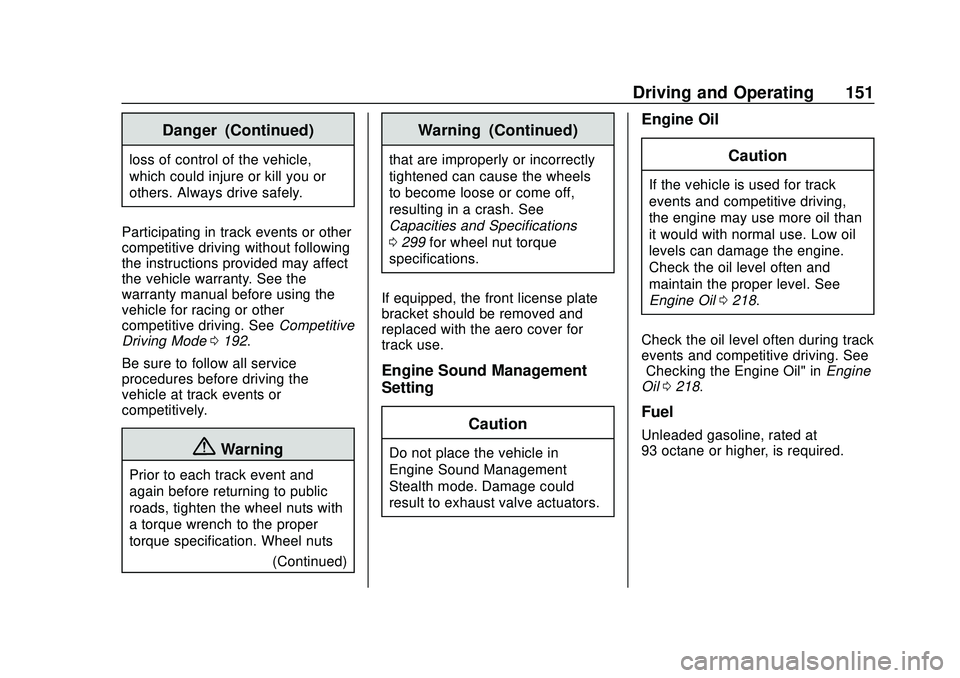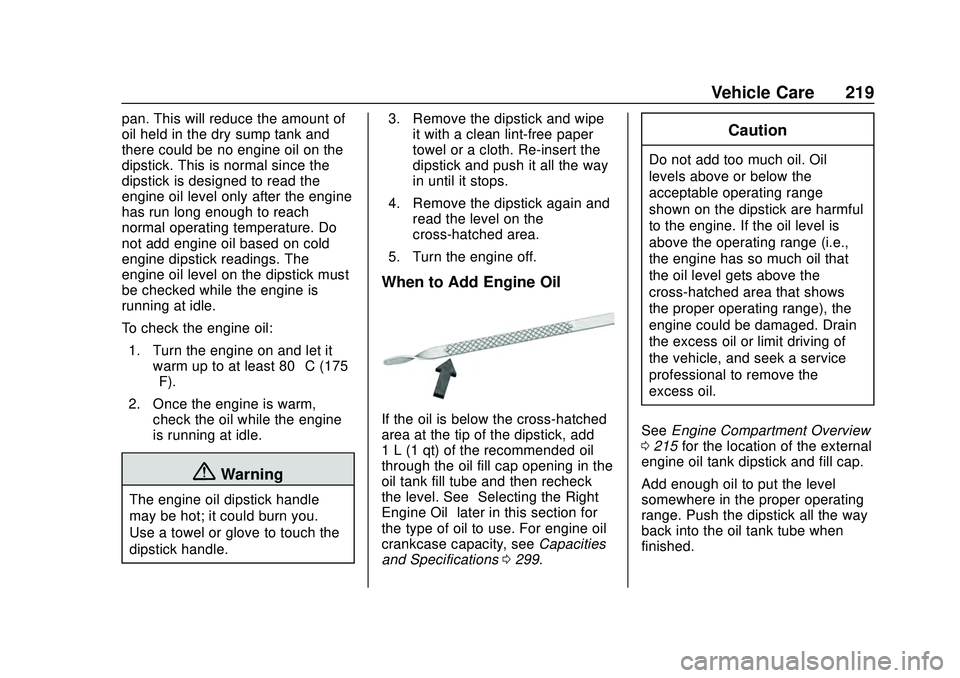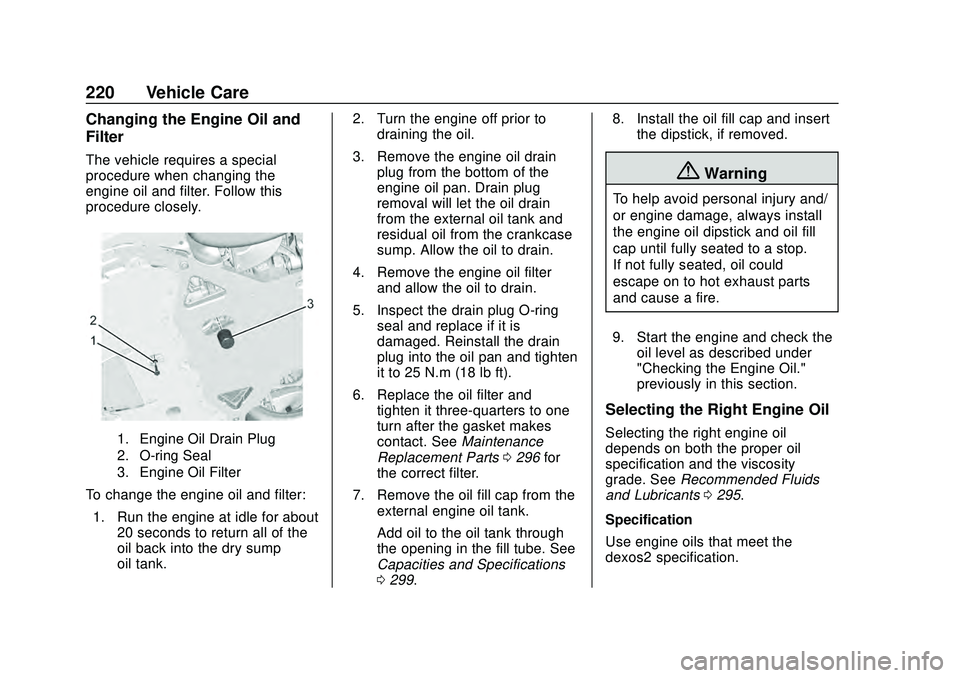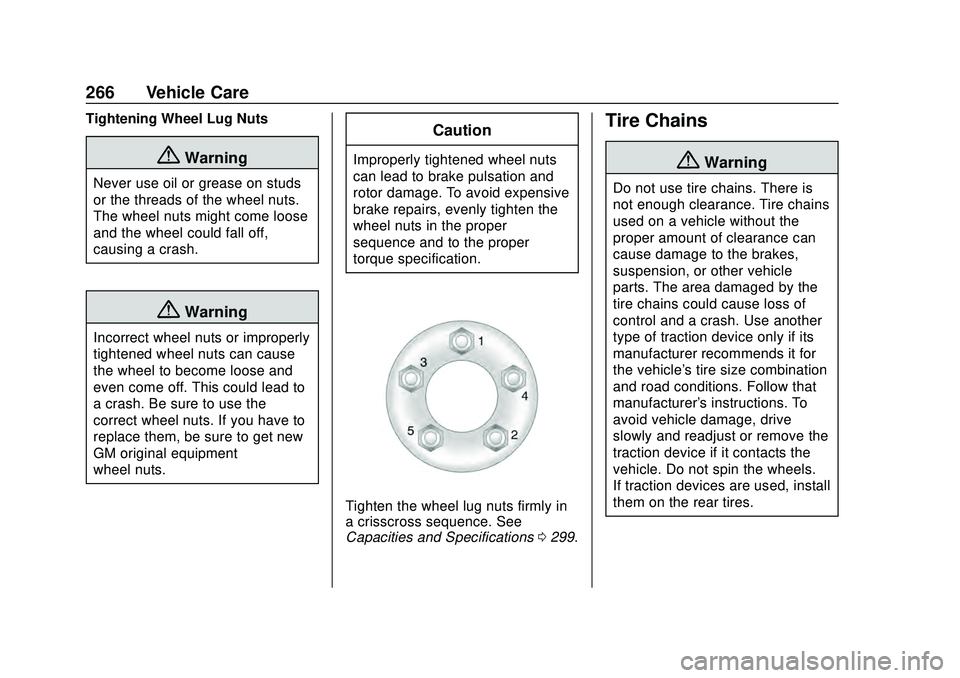oil capacities CHEVROLET CORVETTE 2020 Owner's Manual
[x] Cancel search | Manufacturer: CHEVROLET, Model Year: 2020, Model line: CORVETTE, Model: CHEVROLET CORVETTE 2020Pages: 336, PDF Size: 5.21 MB
Page 152 of 336

Chevrolet Corvette Owner Manual (GMNA-Localizing-U.S./Canada/Mexico-
12470550) - 2020 - CRC - 4/23/20
Driving and Operating 151
Danger (Continued)
loss of control of the vehicle,
which could injure or kill you or
others. Always drive safely.
Participating in track events or other
competitive driving without following
the instructions provided may affect
the vehicle warranty. See the
warranty manual before using the
vehicle for racing or other
competitive driving. See Competitive
Driving Mode 0192.
Be sure to follow all service
procedures before driving the
vehicle at track events or
competitively.
{Warning
Prior to each track event and
again before returning to public
roads, tighten the wheel nuts with
a torque wrench to the proper
torque specification. Wheel nuts (Continued)
Warning (Continued)
that are improperly or incorrectly
tightened can cause the wheels
to become loose or come off,
resulting in a crash. See
Capacities and Specifications
0299 for wheel nut torque
specifications.
If equipped, the front license plate
bracket should be removed and
replaced with the aero cover for
track use.
Engine Sound Management
Setting Caution
Do not place the vehicle in
Engine Sound Management –
Stealth mode. Damage could
result to exhaust valve actuators.
Engine Oil
Caution
If the vehicle is used for track
events and competitive driving,
the engine may use more oil than
it would with normal use. Low oil
levels can damage the engine.
Check the oil level often and
maintain the proper level. See
Engine Oil0218.
Check the oil level often during track
events and competitive driving. See
“Checking the Engine Oil" in Engine
Oil 0218.
Fuel
Unleaded gasoline, rated at
93 octane or higher, is required.
Page 220 of 336

Chevrolet Corvette Owner Manual (GMNA-Localizing-U.S./Canada/Mexico-
12470550) - 2020 - CRC - 4/23/20
Vehicle Care 219
pan. This will reduce the amount of
oil held in the dry sump tank and
there could be no engine oil on the
dipstick. This is normal since the
dipstick is designed to read the
engine oil level only after the engine
has run long enough to reach
normal operating temperature. Do
not add engine oil based on cold
engine dipstick readings. The
engine oil level on the dipstick must
be checked while the engine is
running at idle.
To check the engine oil:1. Turn the engine on and let it warm up to at least 80 °C (175
°F).
2. Once the engine is warm, check the oil while the engine
is running at idle.
{Warning
The engine oil dipstick handle
may be hot; it could burn you.
Use a towel or glove to touch the
dipstick handle. 3. Remove the dipstick and wipe
it with a clean lint-free paper
towel or a cloth. Re-insert the
dipstick and push it all the way
in until it stops.
4. Remove the dipstick again and read the level on the
cross-hatched area.
5. Turn the engine off.
When to Add Engine Oil
If the oil is below the cross-hatched
area at the tip of the dipstick, add
1 L (1 qt) of the recommended oil
through the oil fill cap opening in the
oil tank fill tube and then recheck
the level. See “Selecting the Right
Engine Oil” later in this section for
the type of oil to use. For engine oil
crankcase capacity, see Capacities
and Specifications 0299.
Caution
Do not add too much oil. Oil
levels above or below the
acceptable operating range
shown on the dipstick are harmful
to the engine. If the oil level is
above the operating range (i.e.,
the engine has so much oil that
the oil level gets above the
cross-hatched area that shows
the proper operating range), the
engine could be damaged. Drain
the excess oil or limit driving of
the vehicle, and seek a service
professional to remove the
excess oil.
See Engine Compartment Overview
0 215 for the location of the external
engine oil tank dipstick and fill cap.
Add enough oil to put the level
somewhere in the proper operating
range. Push the dipstick all the way
back into the oil tank tube when
finished.
Page 221 of 336

Chevrolet Corvette Owner Manual (GMNA-Localizing-U.S./Canada/Mexico-
12470550) - 2020 - CRC - 4/23/20
220 Vehicle Care
Changing the Engine Oil and
Filter
The vehicle requires a special
procedure when changing the
engine oil and filter. Follow this
procedure closely.
1. Engine Oil Drain Plug
2. O-ring Seal
3. Engine Oil Filter
To change the engine oil and filter:1. Run the engine at idle for about 20 seconds to return all of the
oil back into the dry sump
oil tank. 2. Turn the engine off prior to
draining the oil.
3. Remove the engine oil drain plug from the bottom of the
engine oil pan. Drain plug
removal will let the oil drain
from the external oil tank and
residual oil from the crankcase
sump. Allow the oil to drain.
4. Remove the engine oil filter and allow the oil to drain.
5. Inspect the drain plug O-ring seal and replace if it is
damaged. Reinstall the drain
plug into the oil pan and tighten
it to 25 N.m (18 lb ft).
6. Replace the oil filter and tighten it three-quarters to one
turn after the gasket makes
contact. See Maintenance
Replacement Parts 0296 for
the correct filter.
7. Remove the oil fill cap from the external engine oil tank.
Add oil to the oil tank through
the opening in the fill tube. See
Capacities and Specifications
0299. 8. Install the oil fill cap and insert
the dipstick, if removed.
{Warning
To help avoid personal injury and/
or engine damage, always install
the engine oil dipstick and oil fill
cap until fully seated to a stop.
If not fully seated, oil could
escape on to hot exhaust parts
and cause a fire.
9. Start the engine and check the oil level as described under
"Checking the Engine Oil."
previously in this section.
Selecting the Right Engine Oil
Selecting the right engine oil
depends on both the proper oil
specification and the viscosity
grade. See Recommended Fluids
and Lubricants 0295.
Specification
Use engine oils that meet the
dexos2 specification.
Page 267 of 336

Chevrolet Corvette Owner Manual (GMNA-Localizing-U.S./Canada/Mexico-
12470550) - 2020 - CRC - 4/23/20
266 Vehicle Care
Tightening Wheel Lug Nuts
{Warning
Never use oil or grease on studs
or the threads of the wheel nuts.
The wheel nuts might come loose
and the wheel could fall off,
causing a crash.
{Warning
Incorrect wheel nuts or improperly
tightened wheel nuts can cause
the wheel to become loose and
even come off. This could lead to
a crash. Be sure to use the
correct wheel nuts. If you have to
replace them, be sure to get new
GM original equipment
wheel nuts.
Caution
Improperly tightened wheel nuts
can lead to brake pulsation and
rotor damage. To avoid expensive
brake repairs, evenly tighten the
wheel nuts in the proper
sequence and to the proper
torque specification.
Tighten the wheel lug nuts firmly in
a crisscross sequence. See
Capacities and Specifications0299.
Tire Chains
{Warning
Do not use tire chains. There is
not enough clearance. Tire chains
used on a vehicle without the
proper amount of clearance can
cause damage to the brakes,
suspension, or other vehicle
parts. The area damaged by the
tire chains could cause loss of
control and a crash. Use another
type of traction device only if its
manufacturer recommends it for
the vehicle's tire size combination
and road conditions. Follow that
manufacturer's instructions. To
avoid vehicle damage, drive
slowly and readjust or remove the
traction device if it contacts the
vehicle. Do not spin the wheels.
If traction devices are used, install
them on the rear tires.
Page 300 of 336

Chevrolet Corvette Owner Manual (GMNA-Localizing-U.S./Canada/Mexico-
12470550) - 2020 - CRC - 4/23/20
Technical Data 299
Vehicle Data
Capacities and Specifications
The following approximate capacities are given in metric and English conversions.
SeeRecommended Fluids and Lubricants 0295.
Application Capacities
Metric English
Air Conditioning Refrigerant For the air conditioning system refrigerant charge type and amount, see the refrigerant label underthe hood. See your dealer for more information.
Engine Cooling System with Performance Package* 21.5 L 22.7 qt
Engine Cooling System without Performance Package* 20.5 L 21.7 qt
Engine Oil with Filter 7.1 L 7.5 qt
Fuel Tank 70.0 L 18.5 gal
Wheel Nut Torque 190 Y140 lb ft
All capacities are approximate. When adding, be sure to fill to the approximate level, as recommended in this
manual. Recheck fluid level after filling
*Engine cooling system capacity values are based on the entire cooling system and its components.